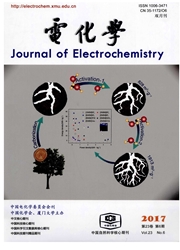

 中文摘要:
中文摘要:
微生物电化学技术(Microbial Electrochemical Technology,MET)作为一种新型水处理工艺,由于具有污染物同步去除和能源化的特点受到广泛重视.近年来,微生物电化学系统(Microbial ElectrochemicalSystem,MES)的研究者在其电子传递机理、功能菌群分析、系统功能拓展、低成本材料开发和大型系统构建等方面取得大量进展.然而,该技术作为污水处理工艺的可行性却始终存在争议.本文从应用角度将MET工艺与现有厌氧、好氧工艺进行对比.分析各工艺在有机物降解和能量回收方面的特点,有助于找到MET工艺在水处理领域中的适宜定位.相对厌氧与好氧工艺。MET工艺具有低污泥产率、运行过程能量自给以及电流加速污染物去除等优势特征,但在推进MET工艺的实用化进程中仍需进一步简化其系统结构、降低构筑成本、提高运行稳定性,并应基于MET的运行特征确定其适宜的应用范围以发挥MET工艺的技术优势.
 英文摘要:
英文摘要:
Microbial electrochemical technology (MET) has drawn great attention for its characteristics of synergetic pollution removal and energy recovery of wastewater. In the last decade, significant developments in microbial electrochemical system (MES) have been made in the aspects of electron transfer mechanism, microbial community analysis, function expansion, low-cost electrode materials and scaled-up constructions. However, the feasibility of MET as a wastewater treatment process has been con- troversial so far. In this paper, the characteristics of MET were systematically compared with anaerobic and aerobic processes from the application point of view in the aspects of pollution degradation and energy recovery processes. The MET-based water treatment technology revealed some comparative advantages for applications because of its low sludge yield rate, energy self-sufficiency operation and current-assisted pollutant removal capability. The better understanding of these advantages would be helpful in finding the proper application scope of MET for wastewater treatment. However, in the process of advancing the practical application of MET, challenges remained require more effort such as the construction simplification, development of low-cost material and maintenance of electrode performance in long-term operation. More considerations were also needed to determine the appropriate application position of MET in a series of water treatment units to overcome shortcomings and take advantages of technical advances.
 同期刊论文项目
同期刊论文项目
 同项目期刊论文
同项目期刊论文
 A dynamic contaminant fate model of organic compound: A case study of Nitrobenzene pollution in Song
A dynamic contaminant fate model of organic compound: A case study of Nitrobenzene pollution in Song Comparing the adsorption and desorption characteristics of 17 alpha-ethinylestradiol on sludge deriv
Comparing the adsorption and desorption characteristics of 17 alpha-ethinylestradiol on sludge deriv Capturing photogenerated electrons and holes at the B/Cl co-modified rutile TiO2 nanorods during org
Capturing photogenerated electrons and holes at the B/Cl co-modified rutile TiO2 nanorods during org Concentrations of polycyclic aromatic hydrocarbons in resuspendable fraction of settled bus dust and
Concentrations of polycyclic aromatic hydrocarbons in resuspendable fraction of settled bus dust and Distribution and fate of synthetic musks in the Songhua River Northeastern China: influence of envir
Distribution and fate of synthetic musks in the Songhua River Northeastern China: influence of envir Anaerobic biodegradation characteristics of estrone, estradiol, and 17 alpha-ethinylestradiol in act
Anaerobic biodegradation characteristics of estrone, estradiol, and 17 alpha-ethinylestradiol in act Assessment on the occupational exposure of urban public bus drivers to bioaccessible trace metals th
Assessment on the occupational exposure of urban public bus drivers to bioaccessible trace metals th Microbial community analysis in a combined anaerobic and aerobic digestion system for treatment of c
Microbial community analysis in a combined anaerobic and aerobic digestion system for treatment of c Simultaneous water desalination and electricity generation in a microbial desalination cell with ele
Simultaneous water desalination and electricity generation in a microbial desalination cell with ele Phosphate-bridged TiO2-BiVO4 nanocomposites with exceptional visible activities for photocatalytic w
Phosphate-bridged TiO2-BiVO4 nanocomposites with exceptional visible activities for photocatalytic w Carbon Footprint Analyses of Mainstream Wastewater Treatment Technologies under Different Sludge Tre
Carbon Footprint Analyses of Mainstream Wastewater Treatment Technologies under Different Sludge Tre Factors affecting microalgae harvesting efficiencies using electrocoagulation-flotation for lipid ex
Factors affecting microalgae harvesting efficiencies using electrocoagulation-flotation for lipid ex Intermittent contact of fluidized anode particles containing exoelectrogenic biofilms for continuous
Intermittent contact of fluidized anode particles containing exoelectrogenic biofilms for continuous Health impact of bioaccessible metal in lip cosmetics to female college students and career women, n
Health impact of bioaccessible metal in lip cosmetics to female college students and career women, n Coupling interaction of cathodic reduction and microbial metabolism in aerobic biocathode of microbi
Coupling interaction of cathodic reduction and microbial metabolism in aerobic biocathode of microbi Combined effects of carbon, phosphorus and nitrogen on lipid accumulation of Chlorella vulgaris in m
Combined effects of carbon, phosphorus and nitrogen on lipid accumulation of Chlorella vulgaris in m Simultaneous current generation and ammonia recovery from real urine using nitrogen-purged bioelectr
Simultaneous current generation and ammonia recovery from real urine using nitrogen-purged bioelectr A 90-liter stackable baffled microbial fuel cell for brewery wastewater treatment based on energy se
A 90-liter stackable baffled microbial fuel cell for brewery wastewater treatment based on energy se Facile Synthesis of N-doped TiO2 and Its Enhanced Photocatalytic Activity for Degrading Colorless Po
Facile Synthesis of N-doped TiO2 and Its Enhanced Photocatalytic Activity for Degrading Colorless Po Combined technology for clomazone herbicide wastewater treatment: three-dimensional packed-bed elect
Combined technology for clomazone herbicide wastewater treatment: three-dimensional packed-bed elect Influence of operating parameters on the fate and removal of three estrogens in a laboratory-scale A
Influence of operating parameters on the fate and removal of three estrogens in a laboratory-scale A 期刊信息
期刊信息
